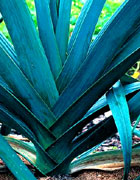


Home
Flowers &
Indoor Plants
Fruits & Nuts
Ornamentals
Vegetables
Special Topics
Resources
Glossary

|
Leek (Porrum Group) Allium ampeloprasum (all-ee-um am-pel-o-pra-sum) 


Click on thumbnails for larger image. |
 |
What about it? Leeks are the most subtly flavored member of the onion family. These biennials are also one of the most beautiful plants in the garden, both during their first vegetative season, and during their second spring, when they send up a tall stalk crowned with a large spherical flower head. The leek is grown for its lower leaf section, which forms a white shank. Leeks do not form an enlarged portion as do onions, but different varieties of leeks have shanks of different diameters and lengths. What is it used for? Leeks can be used in a wide variety of recipes, such as soups, sauces, and stir-fries. In addition, because of their subtle flavor, they are also commonly eaten fresh. Where does it grow? How do we grow it?Leeks prefer deep, rich soil. They are well known as "heavy feeders", meaning that they require a lot of nitrogen. Although they can be grown from seeds, their growing season is from 90-130 days so it is best to start the plants indoors around February or March. Seedlings will need to be thinned so that there are at least 4 inches in between plants. Also, you will have to hill the soil at the base of the leek plant 2 or 3 times throughout the season in order to create the blanched, edible portion of the stem. What are its primary problems? Leeks are relatively pest-free. How do we harvest and store it? Leeks may be harvested at any time. They should be dug with a spade or fork to loosen their many fibrous but shallow roots from the soil. Plants can be injured if they are pulled out by hand. Shake the soil free from the roots. Leeks can be held for several months at low temperatures and in high humidity. They retain their quality best when they are stored in a paper bag in the refrigerator.
© Copyright, Department of Horticulture, Cornell University. |